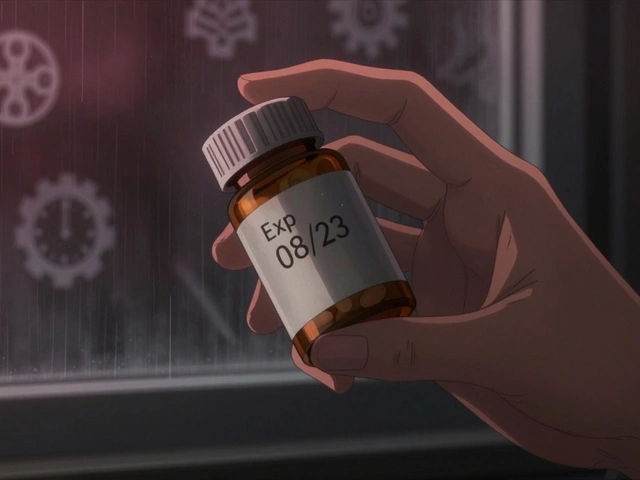One wrong letter on a prescription can land someone in the hospital. That’s not speculation - it’s a documented fact. QD and QID sound similar. They’re both Latin abbreviations used for dosing instructions. But QD means once daily, and QID means four times daily. Mix them up, and a patient gets four times the dose they were supposed to take. For many, that’s not just a mistake - it’s life-threatening.
Why QD and QID Are Dangerous
These abbreviations have been around for centuries. QD comes from the Latin phrase quaque die, meaning “every day.” QID comes from quater in die, meaning “four times a day.” Back when doctors wrote prescriptions by hand, these shortcuts saved time. Today, they’re relics - and deadly ones. The Institute for Safe Medication Practices flagged QD and QID as high-risk in 2001. The Joint Commission added them to their “Do Not Use” list in 2004. Yet, over 20 years later, they’re still showing up on prescriptions. Why? Because some providers still use them out of habit. And because some pharmacies still interpret them without double-checking. A 2018 study in the Journal of Patient Safety found that in simulated prescription reviews, QD was misread as QID in nearly 13% of cases. That’s one in eight prescriptions. For new healthcare workers - those with less than five years of experience - that error rate jumps to 18%. And it’s not just theoretical. Real patients have been hospitalized, had internal bleeding, or suffered dangerously low blood pressure because of this mix-up. One documented case involved a construction inspector who took a sedative four times a day instead of once. He drove his 7-year-old daughter to school every morning for a week. He didn’t realize he was overdosing until he went in for a refill. By then, he’d been functioning in a fog, barely aware of the danger he was in - and putting others at risk.Who’s Most at Risk?
Elderly patients are the most vulnerable. According to the American Geriatrics Society, 68% of all documented QD/QID errors happen in people aged 65 and older. Why? They’re often managing five, ten, or even more medications. Their memory isn’t always sharp. They might not speak up when instructions are unclear. And they’re more sensitive to drug side effects. Take warfarin, a blood thinner. One patient on Reddit shared how a nurse misread “1 tab QD” as “1 tab QID.” The patient ended up with an INR of 12.3 - a level that can cause spontaneous bleeding. They were rushed to the hospital. That’s not a rare story. Community pharmacists report intercepting an average of 2.7 QD/QID misinterpretations per week. That’s nearly 14 a month - just in one pharmacy. Even patients who read their labels carefully get confused. A 2021 survey by the National Patient Safety Foundation found that 63% of patients had been unsure about their dosing instructions at least once. QD vs. QID ranked as the third most confusing instruction, behind “take with food” and “take on empty stomach.”What’s the Real Difference Between QD and QID?
It’s not just about how many times you take the pill. It’s about timing, too. QD means one dose every 24 hours. It doesn’t matter if you take it at 8 a.m. or 8 p.m. - as long as it’s once a day. QID means four doses spread out during your waking hours. That’s not every six hours. It’s not meant to wake you up in the middle of the night. It’s typically around 7 a.m., 1 p.m., 7 p.m., and 10 p.m. - roughly every 6 hours while you’re awake. The goal is steady drug levels without disrupting sleep. The Montana Department of Public Health clarifies this clearly: QID dosing should align with normal waking hours - usually between 6 a.m. and 10 p.m. Same with BID (twice daily) and TID (three times daily). They’re not rigid clock-based schedules. They’re practical, life-friendly ones.
Why Do These Errors Still Happen?
You’d think electronic prescribing would have solved this. But it hasn’t. In 2022, 87% of EHR systems had built-in checks to block QD and QID. That’s progress. But 31% of community pharmacies still see handwritten prescriptions using these abbreviations - mostly from independent doctors who haven’t switched to digital systems. Even in electronic systems, errors creep in. A 2021 analysis by the Agency for Healthcare Research and Quality found that 3.8% of errors still happen when providers manually override the system’s safe defaults. Why? Because they’re rushed. Because they’re used to typing “QD.” Because they don’t realize how dangerous it is. And then there’s the human factor. Pharmacists rely on legibility. Nurses rely on what they’re told. Patients rely on what they read. One misread letter - a dot after the Q, a smudge on the D - changes everything.How to Prevent These Errors
The fix isn’t complicated. It’s simple: stop using abbreviations. Write it out. Instead of “QD,” write “once daily.” Instead of “QID,” write “four times daily.” It takes three extra letters. That’s it. But the safety gain is massive. Dr. Jerry Phillips of ISMP said it best: “With only three more letters than the abbreviation it replaces, writing ‘daily’ offers a much safer alternative.” Here’s what works:- Write it out in full. No Latin. No shorthand. Just clear English.
- Use EHR alerts. Systems should flag any attempt to enter “QD” or “QID” and force the provider to select the full phrase.
- Train staff to ask open-ended questions. Don’t ask, “Is this QD or QID?” Ask, “How often are you supposed to take this medication?” That forces the patient to explain - not just confirm.
- Standardize labels. Use icons alongside text: a sun for once daily, four suns for four times daily. Visual cues reduce confusion.
- Require verbal verification. The University of Michigan found that when pharmacists call patients to confirm dosing instructions, error rates drop by 67%.

What’s Changing - and Fast
Change is happening. And it’s accelerating. In June 2023, the American Medical Association updated its prescribing guidelines to mandate writing out “daily” instead of using QD. The FDA’s 2023 draft guidance says Latin abbreviations should be eliminated entirely. Epic and Cerner - the two biggest EHR systems - now have “hard stops” that won’t let providers save a prescription if it contains QD or QID. The National Action Alliance for Patient Safety launched the “Clear Communication Campaign” in April 2023 with a $45 million investment from CMS. Their goal? Reduce abbreviation-related errors by 90% by 2026. And it’s working. Hospitals that eliminated these abbreviations saw a 42% drop in dosing errors within a year. A Johns Hopkins study in JAMA Internal Medicine showed that adding simple icons to prescriptions cut QD/QID confusion by 82% in a trial of 1,500 patients. The return on investment? $8.70 saved for every $1 spent on training and system updates. That’s not just good safety - it’s smart business.What You Can Do
If you’re a patient:- Always read your prescription label. If it says “QD” or “QID,” ask the pharmacist to explain it in plain words.
- Keep a list of your medications - including dosing instructions - and bring it to every appointment.
- Don’t be afraid to say, “I’m not sure what this means.”
- Stop using QD, QID, BID, TID. Write it out.
- Check your EHR settings. Make sure the system blocks these abbreviations.
- Train your team. Make clear communication part of your culture - not an afterthought.
- When in doubt, call the prescriber. Better to pause than to poison.




jalyssa chea
November 16, 2025 AT 20:57QD vs QID is such a dumb thing to still be happening like we dont have computers now
Julie Roe
November 18, 2025 AT 13:21Ive worked in home health for over 15 years and this is one of the most common errors we catch. Elderly patients especially dont know what QID means and theyll just assume its the same as QD. I had one client take her blood thinner four times a day for a week because the script said QID but she thought it was QD. She ended up in the ER with bleeding gums and a scary INR. Now I always make them read it back to me in plain English. No abbreviations. No Latin. Just words they can understand. Its not hard. Its just care.
Gary Lam
November 19, 2025 AT 11:49So we spent 200 years using Latin because doctors were fancy and now we have to write in English because people are alive? Wild. Next theyll make us say "take two pills" instead of "BID". Next thing you know well be writing "do not drive while drowsy" instead of "caution: may cause drowsiness". The medical world is turning into a kindergarten.
Peter Stephen .O
November 21, 2025 AT 08:43Man this hits different. I used to be a pharmacy tech and I swear half the scripts I saw had QD or QID scribbled like chicken scratch. One time I caught a script where the "D" looked like an "I" because of a smudge. I called the clinic and the doc said "oh yeah I meant QID" but the patient had already picked it up. We had to track her down at work and get her to come back. She was so shaken she cried. That was the day I started yelling at every provider who typed "QD". Three extra letters. Three. That’s it. You wanna save lives? Type "once daily". Its not a burden. Its a moral obligation.
Andrew Cairney
November 21, 2025 AT 10:42QD/QID isn't the real problem. It's the system. They want you to think it's about lazy doctors but its really about pharma pushing meds that need frequent dosing to keep you hooked. They profit more if you take it four times a day. And if you die from a mix-up? Well that's just a cost of doing business. They're not banning QD because they care about you. They're banning it because lawsuits are getting expensive. #BigPharmaLies
Rob Goldstein
November 22, 2025 AT 11:12From a clinical perspective, the real win here is standardization. When you eliminate ambiguous abbreviations, you reduce cognitive load on every link in the chain - prescriber, pharmacist, nurse, patient. It’s not just about QD vs QID. It’s about creating a culture of clarity. EHRs that force full phrases aren’t restrictive - they’re protective. And the data backs it: error rates drop, adherence improves, and patient trust goes up. This isn’t bureaucracy. This is clinical excellence.
vinod mali
November 24, 2025 AT 04:03in india we dont even use qd or qid. we just say "ek baar roz" or "chaar baar roz". simple. no confusion. why do we still use latin in america? its like using roman numerals on clocks in 2025
Jennie Zhu
November 24, 2025 AT 09:09It is imperative that healthcare practitioners adhere to standardized nomenclature in order to mitigate adverse drug events. The persistence of archaic Latin abbreviations constitutes a critical failure in patient safety protocol and must be addressed through mandatory institutional policy enforcement and continuing education.
Robert Merril
November 24, 2025 AT 22:46QD is just QD right? why make it so hard. i mean come on. its one letter off. you think people are that dumb? also i think they should just use dots like Q.D. and Q.I.D. so its clear. that’s how they did it in the 90s
Noel Molina Mattinez
November 25, 2025 AT 09:33you know what else is dangerous? when pharmacists dont even check the script and just fill it. i had a friend get the wrong med because the pharmacist thought "Lanoxin" was "Lantus". same letter count. same first letter. no one checks. so why are we mad at QD? its the whole system that’s broken
Roberta Colombin
November 25, 2025 AT 11:11I love how this article just says "write it out" like that’s the whole solution. It’s so simple. But it’s also so powerful. We don’t need fancy tech. We just need to remember that people are human. And humans need clear words. Not Latin. Not shortcuts. Not assumptions. Just plain language. Thank you for saying it plainly.
Dave Feland
November 26, 2025 AT 08:07Of course they’re banning QD. It’s not about safety. It’s about the ADA. If a patient is "disabled" because they can’t read Latin, then under Title III, healthcare providers are legally obligated to provide accessible instructions. So now we’re not fixing a medical error - we’re complying with litigation-driven linguistic compliance. The real tragedy? We’re losing the intellectual heritage of medical Latin for the sake of legal convenience.
Ashley Unknown
November 26, 2025 AT 20:44They’re hiding something. Why now? Why after 20 years of people dying? Did someone get rich off the lawsuits? Did Big Pharma buy off the Joint Commission? I saw a video of a pharmacist laughing while she filled a QID script for a 92-year-old. And then she said "oh honey you’ll be fine". That’s not negligence. That’s malice. They know. They know. And they don’t care. I’m not taking my meds anymore. I’m going to start a petition. #QDIsACrime
Georgia Green
November 28, 2025 AT 05:32the icons idea is actually really smart. i work with older folks and they remember pictures better than words. a sun for once a day, four suns for four times. even if they cant read they get it. i wish we had that on all scripts. simple, visual, safe.
Christina Abellar
November 29, 2025 AT 03:41Yes. Just say it clearly.